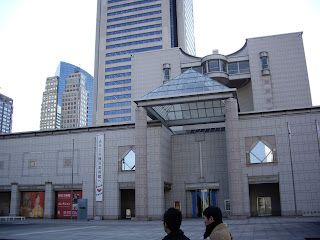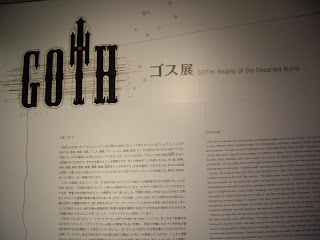"Gothic art what does it mean? The introduction to the exhibit does a good job of describing what the history behind the word Goth comes from but it seems to miss the mark or trying to label artist as goth that may have influenced the sub-culture movement of today. In short, there is confusion as to whether the exhibit is trying to encapsulate the emotion or intention of the sub-culture of goth or instituting and pigeon holing artist as “goth”. An example being, danse macabre, or dance of death, an idea that speaks to the fragility of life and how death unites us all. An idea and art style that has much older and deeper roots then the modern fad goth is today. The first exhibits were from artist from Mexico using this style which seemed a little out of place with the pictures of Japanese youth. I don’t know if you could say the German artist was goth either and the Japanese artist who had the wonderful animation display. The biggest attraction was the pictures of Japanese youth and Pyupuru, who documents her sex change through her art. Pyupuru’s exhibit especially tries to be loud and over the top on purpose with portraits of her covered in meat, mud, paint, etc. The main piece in her exhibit includes a gaudy wedding dress with the train of the dress filling up the entire room. There is no head but the dress is modeled with arms with one extending up giving the viewers the middle finger with a giant drop of blood hanging from that finger.”I noticed no matter how much I edited this there has to be some kind of introduction or knowledge spreading of what exactly is goth. I felt that this is what the art exhibit was trying to do and yet in its flaws I can’t quite think of a way to describe it. The word goth itself isn't enough to describe all the different types and sub-types of fashion and one of the exhibits in the museum tries to explain. At its heart, the word “goth” to me embodies a fashion movement as well as a type of lifestyle. At the least I can show you some pictures of the type of outfits you will find in portions of Tokyo with galleries here, here, and here. Most of the people in these outfits you will find in a place called Harajuku just hanging out with loads of people taking pictures of them. The district is well known for its abundance of fashion shops all catering towards youth. There is an amazing article about this area and its fashion movements here.
“The pictures of Japanese youth as well provoke more questions then answers. Why is it they objectify themselves as dolls, beasts, etc. It seems to be mostly women and I guess Lolita means European doll dress. Seeing the photo shoots of the girls in their bedrooms dressed up makes them look as if they were objects in the room. It seems to say a lot of things about the objectification of women in this culture that has a tendency to put woman on a pedestal. I can’t really tell if dressing up like a porcelain doll is in defiance of this objectification or an absolute acceptance of it. The exhibits are thought provoking and it speaks to some of the realities of the culture and the time period in a way that people don’t want to accept. If gothic as it was originally defined encapsulates words like barbaric and dismantling then Goth culture today is a dismantling of the self?? More thought may be needed but dating and having friends who considered themselves goth and having my own perspective of what the term means I see it as a normal understandable lifestyle choice. However the exhibit and the way goth is presented as a gaudy and striking fashion statement puts the whole thing on some other worldly, outsider perspective. In the society of Japan these people are considered the freaks of society. There is a place in Tokyo where people go just to take pictures of people dressed up in gothic clothes hanging out on the street, playing games and doing activities for the singular purpose of creating photo opportunities for the many visitors. There was one exhibit at the very end where they took pictures of people who visited the museum who appeared or identified themselves as being goth. From my experience with this word in lower education I considered the exhibit to be a little degrading. It would be like if someone where to do an art exhibit on “Jocks” or some ill contrived social grouping of people. While the rebellious youth culture is there it is very apparent to me that what goth means in Japanese has taken a departure from what it means to me and possibly people in the US.”
My final statement in my notebook I think still stands but as far as questions they are still in abundance.


No comments:
Post a Comment